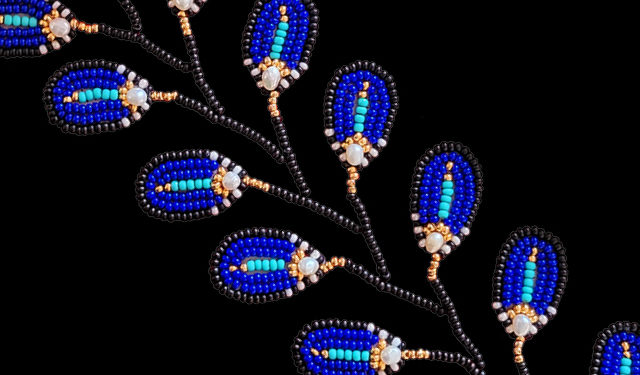The McCord Museum’s newest Artist-in-Residence, Niap, is a Montreal-based multidisciplinary artist from Kuujjuaq, Nunavik. Her sculptures, textiles, and murals are currently displayed in some of Canada’s largest galleries. On March 25, her new exhibit, Piqutiapiit—meaning “precious belongings” in Inuktitut—premiered at the museum, a display of past and present Inuit beading practices that showcases the creative ingenuity of Inuit women. Niap’s collection is a beautiful tribute to the artist’s Inuit identity told through entrancing craftsmanship. The exhibit features photography, crafting tools, and Inuit clothing, including a new beaded tapestry that took Niap six months to complete. The tapestry was inspired by savviqutik—the beaded decorations on the front of Inuit women’s clothing. These decorations are constructed out of suede, cotton, leather, and Caribou hide, but are embellished with ivory, glass, brass, and turquoise beads, as well as freshwater pearls. Niap admitted that although the beads are widely available in Inuit communities, the Caribou hide was tough to source. Even though a savviqutik is typically stitched over the chest of a coat, Niap said she felt inspired to make it into a mural.
“There are a lot of things that inspired my work,” Niap said in an interview with The McGill Tribune. Pointing to a tapestry on the wall, she explained, “This piece in particular, was inspired by the chest piece that you’ll see on Inuit traditional clothing. There’s the ulu that inspired the wood piece. There are a lot of things that inspire, but most, the intricate work on Inuit clothing.” An ulu is an Inuit hand-held knife, many of which are displayed in the exhibit.
Upon entering the exhibition, one encounters a series of black-and-white photographs of Inuit women dressed in beautifully intricate beaded parkas lining the walls. These forays into the history of Inuit women’s clothing provide a visual history that sheds light upon Niap’s own creations, such as her own hand-beaded chest piece hanging up on the back wall. During a tour of the exhibit, Niap explained that even to this day, the creation of the garments is an activity reserved for the women and girls of the community. Contrast, yet continuity, between grayscale photos and Niap’s vibrantly coloured creations create a timeline of Inuit women’s clothing that culminates in an explosion of colour, marking Niap’s creations as culturally celebrative pieces that speak to both the past and present of Inuit women’s artistry.
Indeed, Niap recalled the important role beading played in connecting her to family and, particularly, her female relatives: The artist began beading at a young age, with her grandmother and cousins. The entire exhibit exudes a familial air. For instance, a mother’s coat known as an amauti, retrieved from the McCord Museum’s Indigenous Cultures Collection, sits adjacent to Niap’s own creations. Such coats are typically worn by mothers carrying babies, who ride in a snuggly pouch, or an amaut, below the mother’s hood. One can also find examples of such coats in photographs on the walls, worn by the women of Inuit history.
The exhibit also displays an impressive collection of small tools and crafting artifacts that Inuit women use in the beading and sewing of clothing, including items such as thimbles made of Caribou bone and needle cases made of animal hide. These items are also accompanied by a series of small knives, referred to as women’s knives, and a qulliq, a traditional seal oil lamp. Described by the artist as “precious little things,” such tools complete the narrative of Inuit creativity that Piqutiapiit weaves together: Photographs tell a visual history of Inuit garments, while tools represent each stage of such garments’ production—from the cutting of fabric to the stitching of beads. Along with Niap’s savviqutik, the multiple objects of Piqutiapiit come together into a tapestry-like story not just about Niap as a female Inuk designer, but of generations of Inuit women, using small tools, beads, and most importantly, creative innovation, to keep Inuks not just warm, but stylish.
“I hope [visitors] take away the pure ingenuity and the pure talent that Inuit women had and continue to have today, and the patience and perseverance it takes to make something like the coats and the clothing and the kayak,” Niap said. “I really hope people realize how much time is spent with such little material, all these handmade items.”
Piqutiapiit remains open until Aug. 21 at the McCord Museum.








